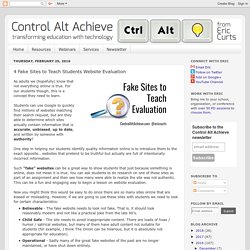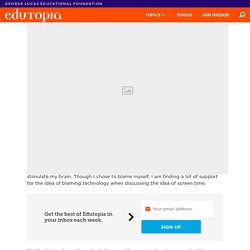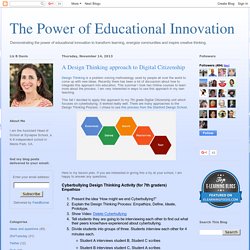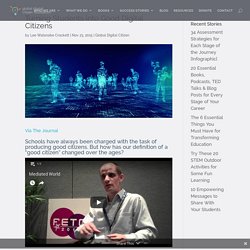

Privacy Training. Control Alt Achieve: 4 Fake Sites to Teach Students Website Evaluation. As adults we (hopefully) know that not everything online is true.

For our students though, this is a concept they need to learn. Be Internet Awesome - Resources. Decreasing Teen Dating Violence Online. Log In. Reframing the Debate About Screen Time. At the end of 2016, I found myself mentally exhausted and barely able to string together a coherent thought or formulate an original idea.

As I swiped through my social media feeds for inspiration—or maybe procrastination—a nagging feeling hit. I needed a break from screen time. Pediatricians, psychologists, and neuroscientists warn of potential negative consequences associated with constant mental stimulation as a result of interacting with our devices. Without a screen-free space for my brain to relax, stop firing, and just think, I felt incapable of significant mental processing. I could blame the technology for thwarting my attempts at creative thought, or I could blame myself for taking the easy route and using my devices to constantly stimulate my brain.
Mobile devices have the potential to provide amazing learning opportunities as well as great distractions. Inner Focus Outer Focus. 8 digital life skills all children need – and a plan for teaching them. A generation ago, IT and digital media were niche skills.

Today, they are a core competency necessary to succeed in most careers. That’s why digital skills are an essential part of a comprehensive education framework. Without a national digital education programme, command of and access to technology will be distributed unevenly, exacerbating inequality and hindering socio-economic mobility. What’s your DQ? The challenge for educators is to move beyond thinking of IT as a tool, or “IT-enabled education platforms”. Like IQ or EQ – which we use to measure someone’s general and emotional intelligence – an individual’s facility and command of digital media is a competence that can be measured. DQ can broadly be broken down into three levels: Classroom resources.
The "New and Improved" Digital Citizenship Survival Kit. Columbia University Libraries. Copyright resources for teachers. August 12, 2014 Now that the new school year is about to start, it would be great to devote a session with your students where you can talk to them about issues related to copyright and proper use of digital artifacts from the net.

This will definitely help them make better and informed decisions as to the kind of materials they are allowed to use in their work and provide them with practice on the different ways they can appropriately credit sources. This resourceful page embeds a wide variety of materials to use in this regard, browse through the items featured there and bookmark the ones you plan to use with your students. I am also sharing with you this wonderful graphic that debunks 5 myths about copyright infringement. You can print it off and use it in your class as well. Click here to access the full version of this visual. Copyright and Fair Use Guidelines. Digital Passport by Common Sense Media. A Design Thinking approach to Digital Citizenship.
Design Thinking is a problem solving methodology used by people all over the world to come up with new ideas.

Recently there has been a lot of discussion about how to integrate this approach into education. This summer I took two Online courses to learn more about the process. I am very interested in ways to use this approach in my own teaching. This fall I decided to apply this approach to my 7th grade Digital Citizenship unit which focuses on cyberbullying. It worked really well. Here is my lesson plan. Cyberbullying Design Thinking Activity (for 7th graders) Empathize Present the idea “How might we end Cyberbullying?”
Define: Students share with the class what they learned about cyberbullying from their research. Ideate: Each group on chart paper brainstorms 100 ideas for solutions in 15 minutes.Post chart paper and all students look at all solutions.Each student has 5 post it notes and votes on the top 5 ideas they see (different color for each group).Groups pick one idea to work on. Welcome, Educators — ikeepsafe.org. Administrators and teachers are urgently looking for a proven system that will guide them through the complexities of Web 2.0.

Too often, events like cyberbullying, sexting, plagiarizing and hacking push litigious chaos into the forefront of technology adoption, essentially stunting the development of digital citizenship progress. Digital_citizenship_starter_kit_0. Turning Students into Good Digital Citizens. Via The Journal Schools have always been charged with the task of producing good citizens.

But how has our definition of a “good citizen” changed over the ages? Video Exclusive: Cultural anthropologist Michael Wesch at Kansas State University discusses the tools today’s students need to be good digital citizens. In today’s world of near-ubiquitous connectivity, in which ordinary people have almost instantaneous access to unlimited stores of information and the ability to interact with anyone, anywhere, anytime, what does it mean to be an effective citizen? What skills and knowledge do our students need to participate fully in a world transformed by technology? Ask a K-12 educator these questions and chances are the answers will have something to do with teaching proper behavior and setting appropriate prohibitions.
‘A Day-to-Day Skill Set’ In his work, Kahne focuses on the connection between students’ participation with digital media and their levels of civic engagement. Susan E.